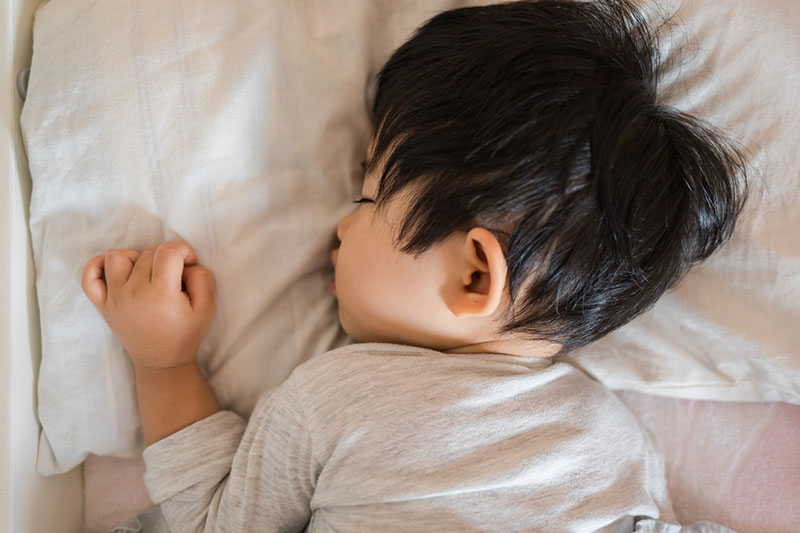Families For Life | Preschooler Sleep: What to Expect

Most pre-schoolers need 10-13 hours of sleep a night, and some still nap during the day. Pre-schoolers sometimes have sleep problems like getting out of bed, as well as nightmares and night terrors. A consistent bedtime routine is the best way to handle many pre-schooler sleep problems.
Pre-schooler sleep: What you need to know
Children aged 3-5 years need around 10-13 hours of sleep a night. Some might also have a day nap of about an hour.
Sleep is important for your pre-schooler’s health, growth and development. When children sleep well, they’re more settled and happier during the day. Getting the right amount of sleep also strengthens your child’s immune system and reduces the risk of infection and illness.
Night terrors and nightmares
Night terrors and nightmares are quite common among pre-schoolers. Night terrors and nightmares happen at different times of the night, and they need to be managed differently.
Night terrors
Night terrors happen in the first few hours of the night, when children are in deep sleep. If your child is having a night terror, he’s actually asleep although he looks like he’s awake. For example, his eyes might be open or he might be moving around. However, he won’t respond to you as he normally would.
Night terrors can be frightening to watch, but they don’t hurt your child.
Don’t wake your child during a night terror, because this often makes it last longer. Instead, wait for your child to stop crying and thrashing about. Guide him back to bed if he has climbed out. Children usually settle back to sleep quickly after a night terror and have no memory of it in the morning.
Nightmares
Nightmares tend to happen in the second half of the night, when children dream the most. They’re related to pre-schoolers’ developing imaginations. If your child has a nightmare, he might wake up upset. He’ll be able to remember the nightmare and talk to you.
If your child has a nightmare, he’ll need cuddles, comfort and reassurance – for example, ‘Bad dreams are very scary, aren’t they?’ Your child might take a while to go back to sleep.
Bedtime routine
Sleep can sometimes come more slowly for pre-schoolers because they’re busy thinking about the day even after they go to bed. A positive bedtime routine can help with this, especially if you follow the routine consistently, both during the week and on weekends.
A bedtime routine for pre-schoolers might look something like this:
7.30 pm: brush teeth, go to toilet, put on night nappy if needed.
7.45 pm: quiet time – read a book, tell a story, sing a song, have a cuddle.
8 pm: get into bed and kiss goodnight.
Most pre-schoolers are ready for bed around 8 pm, especially if they’ve had a big day at pre-school. However, some can demand more and more bedtime stories as a delaying tactic. You might want to establish a two or three book rule for bedtime, with the promise to read more during the day.
If your child needs a pacifier to go to bed, you might consider encouraging him to let go of the pacifier around this time.
Getting up after bedtime
Your pre-schooler might go through a stage of calling out from bed or getting up after you’ve said goodnight. Try these tips:
Avoid boisterous play as well as watching TV and using computers, phones or tablets close to bedtime. These activities can make it harder for your child to settle.
Establish a consistent, calming bedtime routine.
Make sure your child’s room is quiet, dimly lit and neither too hot nor too cold.
Before leaving the room, check that your child has everything he needs for sleep, like his favourite cuddly toy or blanket. Remind him to stay quietly in bed.
If you want to establish a routine that doesn’t involve going in to your child each time he calls out, try to be consistent and respond only if you think he really needs something.
If your child gets out of bed, calmly ask him to go back to bed. Say that you’re just in the other room. Repeat this firmly and quietly over and over until your child doesn’t get up again.
Sometimes your child might actually need something. If your child is scared of a monster under the bed, quickly check and tell your child there are no monsters. Your child might settle after this. If your child is scared of the dark, think about using a night-light.
If your child is having sleep problems, it’s often best to deal with them using behaviour strategies like bedtime routines. Sleep medications aren’t usually the solution to children’s sleep problems.
Night-time wetting
Even if your child uses the toilet or potty during the day, he might still wet at night.
Putting a night-light on and a potty in your child’s room might prompt your child to pee there during the night. Let your child know that you’ll help if he needs it. You can also get night-time nappies or pull-ups for older children.
Night-time wetting is most common in children under seven years, but it also happens in older children. Most children grow out of night-time wetting by themselves. However, if you’re concerned about your child’s night-time wetting, talk to your General Practitioner (GP) or paediatrician.
Sleep and children with autism spectrum disorder
Children with autism spectrum disorder (ASD) can have trouble getting to sleep and staying asleep, just like other children. They can also have different or more severe sleep problems like sleeping at irregular times, sleeping less than expected for their age, getting up in the night or being very sleepy in the day.
You can deal with sleep problems in children with ASD by using behaviour strategies and encouraging healthy sleep habits.
© raisingchildren.net.au, translated and adapted with permission
Explore more